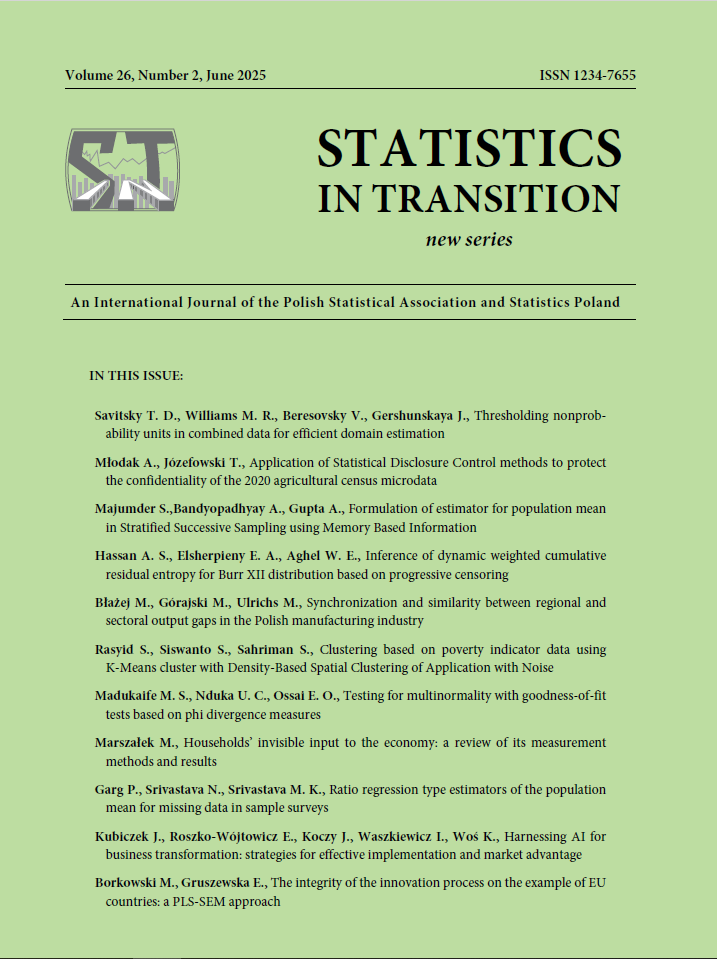ARTICLE
ABSTRACT
The notion of the output gap is crucial in understanding underlying economic trends. The macroeconomic stabilization policy can only be effective for all sectors or regions of the economy if regional or sectoral output gaps are sufficiently coherent. This study proposes a new microeconometric model to calculate regional and sectoral output gaps in Poland's manufacturing industry over the period 2009–2020. The model is estimated using official data sources, which include capacity utilization from business tendency surveys and annual enterprise activity reports. To address potential endogeneity issues, the estimation employs control function methods. We assess the synchronization and similarity of the sectoral and regional output gaps in Poland's manufacturing industry. We also analyze the impact of the COVID-19 pandemic on the coherence of regional and sectoral output gaps.
KEYWORDS
output gap coherence, capacity utilization, control function method, sectoral and regional output gaps, COVID-19
REFERENCES
Ackerberg, D. A., Caves K. and Frazer G., (2015). Identification Properties of Recent Production Function Estimators. Econometrica, 83(6), pp. 2411–51. https://doi.org/10.3982/ECTA13408.
Álvarez, L. J., Gómez-Loscos, A., (2018). A Menu on Output Gap Estimation Methods. Journal of Policy Modeling, 40(4), pp. 827–50. https://doi.org/10.1016/j.jpolmod.2017.03.008.
Blagrave, P., Garcia-Saltos, R., Laxton D. and Zhang F., (2015). A Simple Multivariate Filter for Estimating Potential Output. IMF Working Papers, 15(79), pp. 1. https://doi.org/10.5089/9781475565133.001.
Blażej, M., Górajski, M. and Ulrichs, M., (2025). Microdata-based Output Gap Estimation Using Business Tendency Surveys. Journal of Economic Dynamics and Control, 174, pp. 1–18. https://doi.org/10.1016/j.jedc.2025.105068.
Blondeau, F., Planas, C. and Rossi A., (2021). Output Gap Estimation Using the European Union’s Commonly Agreed Methodology: Vade Mecum & Manual for EUCAM Sotfware, vol. 148. Luxembourg: European Commission’s Directorate- General for Economic and Financial Affairs. https://doi.org/10.2765/217592.
Blundell, R., Bond, S., (2000). GMM Estimation with Persistent Panel Data: An Application to Production Functions. Econometric Reviews, 19(3), pp. 321–40. https://doi.org/10.1080/07474930008800475.
Chalaux, T. Guillemette, Y., (2019). The OECD Potential Output Estimation. OECD Working Papers, ECO/WKP/32, pp. 1–28.
De Haan, J., Jacobs, Jan P.A.M. J and Zijm, R. (2024). Coherence of Output Gaps in the Euro Area: The Impact of the COVID-19 Shock. European Journal of Political Economy, no. 84. https://doi.org/10.1016/j.ejpoleco.2023.102369.
Edge, R., M, Rudd, J., B., (2016). Real-Time Properties of the Federal Reserve’s Output Gap. Review of Economics and Statistics, 98(4), pp. 785–91. https://doi.org/10.1162/REST_a_00555.
Fernald, J. G., (2012). A Quarterly, Utilisation-Adjusted Series on Total Factor Productivity. Federal Reserve Bank of San Francisco, Working Paper Series 2012– 19, pp. 01–28. https://doi.org/10.24148/wp2012-19.
Gali, J., (2009). Monetary Policy, Inflation, and the Business Cycle: An Introduction to the New Keynesian Framework. Princeton University Press.
Gosińska, E., Górajski, M. and Ulrichs, M., (2024). Micro-firms’ productivity growth in Poland before and during COVID-19: Do industry and region matter? Entrepreneurial Business and Economics Review, 12(2), pp. 177–200.
Górajski M., Błażej M., (2020). A control function approach to measuring the total factor productivity of enterprises in Poland Bank i Kredyt, 51, pp. 293–316
Gradzewicz, M., J. Growiec, M. Kolasa, Ł. Postek and P. Strzelecki, (2017a). Poland’s Uninterrupted Growth Performance: New Growth Accounting Evidence. Post- Communist Economies, 30(2), pp. 238–72. https://doi.org/10.1080/14631377.2017.1398519.
Graff, M., Strum, J.-E., (2010). KOF Working Papers. KOF Working Papers, no. 269, pp. 2–32. https://doi.org/10.3929/ethz-a-006070989.
Greenwood, J., Zvi, H. and Huffman G. W., (1988). American Economic Association Investment, Capacity Utilisation, and the Real Business Cycle. American Economic Review, 78(3), pp. 402–17.
Havik, K., Mc Morrow, K., Orlandi, F., Planas, C., Raciborski, R., Röger, W., Rossi, A., Thum-Thysen, A. and Vandermeulen, V., (2014). The Production Function Methodology for Calculating Potential Growth Rates & Output Gaps, Vol. 3187. https://doi.org/10.2765/71437.
Hagemejer, J., Kolasa, M. (2011). Internationalisation and economic performance of enterprises: Evidence from polish firm-level data. World Economy, 34(1), pp. 74– 100. https://doi.org/10.1111/j.1467-9701.2010.01294.x
Jokubaitis, S., Celov, D., (2023). Business Cycle Synchronization in the EU: A Regional- Sectoral Look through Soft-Clustering and Wavelet Decomposition. Journal of Business Cycle Research. Springer International Publishing. https://doi.org/10.1007/s41549-023-00090-4.
Kripfganz, S., (2020). Generalized Method of Moments Estimation of Linear Dynamic Panel-Data Models.
Levinsohn, J., Petrin, A., (2003). Estimating Production Functions Using Inputs to Control for Unobservables. Review of Economic Studies, 70(2), pp. 317–41. https://doi.org/10.1111/1467-937X.00246.
Mink, M., Jacobs, Jan P.A.M. and De Haan, J., (2012). Measuring Coherence of Output Gaps with an Application to the Euro Area. Oxford Economic Papers, 64(2), pp. 217–36. https://doi.org/10.1093/oep/gpr049.
Ódor, L., Kucserová, J. J., (2014). Finding Yeti: More Robust Estimates of Output Gap in Slovakia. Council for Budget Responsibility Working Paper 2.
Olley, G S., Pakes, A., (1996). The Dynamics of Productivity in the Telecommunications Equipment Industry. Econometrica, 64(6), p. 263. https://doi.org/10.2307/2171831.
Orphanides, A., Van Norden, S., (2002). The Unreliability of Output-Gap Estimates in Real Time. The Review of Economics and Statistics, 84(4), pp. 569–83.
Planas, C., Roeger, W. and Rossi, A., (2013). The information content of capacity utilisation for detrending total factor productivity. Journal of Economic Dynamics and Control, 37(3), pp. 577–590.
Peykov, N., (2021). Sectoral Output Gaps – Estimates for Bulgaria. Economic Alternatives, no. 1, pp. 5–26. https://doi.org/10.37075/EA.2021.1.01.
Phillips, P. C. B., Shi, Z., (2021). Boosting: Why You Can Use the HP Filter. International Economic Review, 62(2), pp. 521–70. https://doi.org/10.1111/ iere.12495.
Pu, Z., Fan, X., Xu, Z. and Skare, M., (2023). A Systematic Literature Review on Business Cycle Approaches: Measurement, Nature, Duration. Oeconomia Copernicana, 14(3), pp. 935–76. https://doi.org/10.24136/oc.2023.028.
Quast, J., Wolters, M. H., (2020). Reliable Real-Time Output Gap Estimates Based on a Modified Hamilton Filter. Journal of Business and Economic Statistics, 0(0), pp. 1– 34. https://doi.org/10.1080/07350015.2020.1784747.
Statistics Poland, (2019). Methodological Report. Non-financial Enterprises Survey, Warsaw.
Statistics Poland, (2023). Methodological Handbook. Business Tendency Survey, Warsaw.
Van Beveren, I., (2012). Total Factor Productivity Estimation: A Practical Review. Journal of Economic Surveys, 26(1), pp. 98–128. https://doi.org/10.1111/j.1467-6419.2010.00631.x.
Walsh, Carl E., (2010). Monetary Theory and Policy. The MIT Press Cambridge Massachusetts. Third Dition. Cambridge: The MIT Press. https://doi.org/10.1007/s11293-007-9065-y.
Wen, Y., (1998). Capacity Utilisation under Increasing Returns to Scale. Journal of Economic Theory, 81(1), pp. 7–36. https://doi.org/10.1006/jeth.1998.2412.
Woodford, M., (2003). Interest and Prices. Interest and Prices. Princeton: Princeton University Press.
